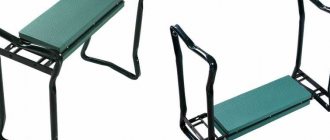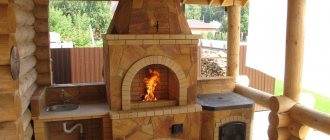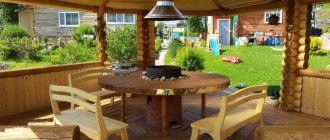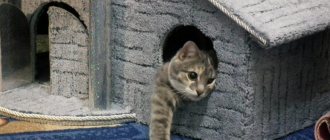Brick beds help make the area beautiful and well-groomed. But beauty is not everything. In addition to the unconditional aesthetics of the design, this brick structure prevents the formation of rot and the washing away of the useful fertile layer of soil (humus). By properly filling and using nets at the base of the bed, plants can be protected from pests and moles.
Brick beds: features
Fencing flower beds and beds with bricks is considered a rather beautiful and durable solution for landscape design, whether in the countryside or in a suburban area. But you should know that in order to build such structures, you need to take into account the interesting features of stone structures.
It is believed that brick fences, especially high ones, are immovable, so they are erected as a permanent structure. Although if it is really necessary to move the structure, then such a structure will need to be disassembled entirely.
Such a structure consists of brick walls, reaching a height in some cases of up to 100 centimeters. In order for the structure to be quite stable, it is necessary to carry out the technology of constructing a brick wall, and under its base a solid foundation is made, in this case a strip foundation.
An important feature of brick fencing is the huge number of different shapes. They have the shape of a square, circle, rectangular, and also more complex, with a combination of different heights and any geometry. Such designs are perfect for any perfect plot of land and therefore have recently gained great popularity among gardeners and farmers.
Canopy and finishing installation
Canopy requirements:
- Single - covers both the grill and the adjacent recreation area.
- Supports
– located at least 16 cm from the grill.
– attached to a plinth or installed on a concrete base.
- made of wood or metal.
– before installation, they are treated with an antiseptic.
- Roof material – any.
- Sanding with a special machine.
- Decorative stones.
- Paint specially designed for brick kilns.
- Decorative plaster, etc.
What is the function of a fence for beds made of bricks?
Such a brick fence, as a rule, performs two main functions - practical and decorative. Brick beds are:
- Design solution for a personal plot. Brick beds very effectively and beautifully decorate absolutely all the plants on the plot of land. They are erected as a separate element, or as part of a general architectural and design solution.
- Performing protective functions of plants. Quite tall brick structures help protect cultivated crops from various pests, rodents and weeds. Also, thanks to them, the flowering period of plants noticeably increases, as well as their growth and fruiting.
- Functions of the territory separator, as well as its designation. Thanks to such structures, it is possible to divide the entire total area of the site into separate zones for planting berries, vegetables and ornamental crops. They also determine the location of various plantings and paths passing between them.
How to create a brick structure to protect plants from pests?
Very often, garden and vegetable crops suffer from the influence of moles. Therefore, summer residents try to arrange high-type beds with additional protection from such pests.
First you need to calculate the amount of material used. It is recommended to remove the turf along the perimeter of the bed, since the growing grass will cause clogging of the cultivated plantings.
Next, you need to mark the dimensions using stakes and construction cord for such purposes. After this, you need to level the area, especially in the area where the bricks will be placed.
After marking the contours of the beds, you should stick to the exposed cord and begin laying out the first brick row. It is not necessary to make the masonry perfectly level, since the structure may still sag a little as a result of rain.
After laying out the first row, you should check whether the fences are equal diagonally, and then look for defects and eliminate them. Then the bricks need to be removed, and a protective layer against moles must be laid on the bottom of the hole. Initially, it is necessary to place a mesh of galvanized material on the soil. On top you need to lay a layer of geotextile or black agrofibre.
If you want to build a higher structure, you need to lay 1-2 more rows of bricks. If you use hollow blocks, then you must fill the cells with the required amount of soil.
What are the advantages and disadvantages of DIY brick beds?
Brick beds have their own personal advantages and disadvantages. And before you make such a structure on your site, be sure to familiarize yourself with them first so that there are no all kinds of unpleasant situations.
Here are the most important and well-known advantages of such structures:
- Quite neat, pleasant and aesthetic appearance.
- High level of durability and strength of this structure.
- Fairly rapid warming of the soil in spring.
- Quite easy to care for.
- Provides good protection of ornamental and vegetable crops from various pests and weeds.
- Significant increase in the fruiting period.
Such fences also have some disadvantages :
- The process of constructing a brick structure is quite complex.
- Impossibility of moving the structure.
- The soil dries out fairly quickly.
- Such fences are very attractive to cats.
Remember that a tall brick structure is considered a fairly solid structure that cannot be moved or altered. Therefore, before creating such a structure, pay special attention to its future location, shape, and size.
How to fill the frame
A high bed is filled with organic matter in layers, the thickness of each layer (except for the bottom) is up to 10 cm. With a minimum (20–25 cm) height of the sides, you will have to bury the entire structure into the soil by about the same amount. Each filled layer is spilled with warm water, leveled and compacted well:
- The base is a fine-mesh metal mesh or geotextile. This will provide protection from moles and rodents. You can use thick cardboard, but it is less effective.
Cardboard can also be used to line the bottom of a high bed, but it does not protect against rodents nearly as effectively as mesh or geotextiles
Large pieces of wood in a raised bed act as drainage
To fill the frame of a high bed, you can use waste from the kitchen - for example, peeling vegetables and fruits
You still can’t do without fertile soil in a high bed
Video: organic “layer cake” on a high bed
How to make a bed out of brick - technology
There are two options for the technology of constructing such beds with your own hands - these are beds with high sides made of bricks and low fences of one or two bricks.
Any brick can be used for this. Either old, left over from renovation or construction, or new, specially purchased for these purposes.
Such structures differ mainly in their height and implementation methods. If you want to build a brick structure that is tall in size, then you should make a strip foundation. In addition, to install such beds you need to know the technology of building brick walls.
But the construction of fairly low beds made of brick is not a difficult process at all, which even a beginner can handle.
If you still decide to construct raised beds made of brick, then you may need the following items:
- Crushed stone, cement, sand.
- Bricks.
- Lumber to make formwork.
- Knitting wire, steel reinforcement.
- Construction level, tape measure, trowel, string, shovel, bayonet shovel. And also a bucket for mixing cement mortar.
Action plan for building a tall brick structure with your own hands:
- On a personal plot, the desired location is selected in advance and then pegs are driven in over the entire area of the future brick bed. A cord is stretched between these pegs. Thanks to this, the place for the future foundation becomes clear. And at the place where the cord is tensioned, you should dig a trench, at least 30 centimeters deep and about 20 centimeters wide, for such a design.
- After digging a trench, sand should be poured onto its bottom. Approximately the layer of sand should be 12-15 centimeters. This sand needs to be compacted and watered.
- Next, reinforcement is laid in two rows across the entire area of the trench, and formwork is made from old edged boards. At a height of about 10-15 centimeters from the soil level, the foundation is poured with concrete. After pouring, it must dry, so it is left to stand for about 2.5 weeks. And after the foundation has completely dried, the laying of bricks begins, and this is done from the corners.
- Such a brick structure can be of any height, from 30 centimeters to one meter. The top row of bricks can be covered with a plastic or wooden panel, as well as galvanized sheets.
If you follow this sequence of actions correctly, you can erect brick structures quite professionally. Well, after the brickwork has completely dried, they begin to fill it with certain layers in the following sequence:
- Protective layer (metal mesh),
- Active layer (wooden logs, plant bark with branches, paper scraps),
- Nutrient layer (cut grass with fallen leaves) and fertile soil.
Another way to make a bed out of brick is to simply line it with brick. This process is much easier than constructing a raised bed, as this method does not require pouring a foundation. And this also means that the ridge may well be moved to another site.
This is done
brick fencing in these ways:
- Place bricks on top of each other diagonally.
- Edging the ridge in one or a double row of bricks, without deepening.
- Lay the brick fence in one row with the recess.
The brick fence, which is laid out diagonally, has a jagged appearance and looks quite beautiful. A shallow trench is dug; its bottom is filled with sand, which should be compacted. Then such a structure can be completed in two ways: using liquid cement mortar, or not doing it.
The ridges that have a border with one row of bricks . And if the row-spacing is also lined with garden slabs, expanded clay or crushed stone, then this creates a truly beautiful look. In addition, the position of the brick can be completely different, and the structure can also be made in different shapes.
To erect such a structure, first outline the place where it will be located and its shape. Then they begin to dig a trench, this is if the brick is laid out high and buried halfway into the soil.
Although it can be laid directly on the soil. True, in this option it is necessary to make the masonry wider, flat. This will allow the border to be stronger, stronger and wider, so that it will not be able to move during agricultural work.
Advice from professionals
At first glance, edging ridges with brick fences seems like a simple matter. In fact, here you need to know the requirements for structures and the intricacies of construction. Advice from professionals will help you avoid making serious mistakes:
- High ridges are filled with a substrate, prepared soil or organic matter. You cannot walk on the filler. To make it convenient to serve plants from both sides, the width of the fence is made to a maximum of 1.2 m. If it is possible to approach from one side, the parameter is reduced to 0.8 m.
- To maintain moisture, the soil on high ridges is mulched. Peat, sawdust, small straw and other dry organic matter are suitable.
- It is better to organize drip irrigation with automated water supply.
- Before loading the soil, the bottom of the pit is covered with galvanized mesh. It will protect the entry of rodents from the garden.
- To maintain soil nutrition, organic fertilizers are periodically applied.
- Before wintering, the soil is covered with leaves, sawdust, and straw. Organic matter will reduce the likelihood of soil freezing and destruction of useful components.
It is easier to lay out fences along a stretched cord
. By following the simplest tips, a gardener will greatly facilitate his task of caring for plantings.
Brick beds in a greenhouse
In a greenhouse, fences can be made of completely different materials, but as for the sides made of brick, this is undoubtedly the most reliable and durable material. With a certain structure, it will be quite possible to sit on them, or use them as small tables for a variety of purposes.
To make such beds in greenhouses, use red, white bricks or paving stones. Such brick structures look great when the floor is laid with tiles, paving stones or large fractional expanded clay.
In a greenhouse, brick structures can have different heights. They also perform the function of a “warm bed” quite well and can tolerate high humidity remarkably well. Plus, their period of operation has an unlimited amount of time.
Such structures are made in a greenhouse according to the same scheme as in an open space. A foundation is provided for high brick beds even at the time of pouring the general foundation of the greenhouse itself. And low structures without a foundation are built after the entire installation and installation of the greenhouse, directly on site.
Step-by-step instructions or how to avoid mistakes
Brick-lined beds have a beautiful, neat appearance and will fit into the interior of any home area. The process of laying a fencing structure is as follows:
- In the selected area, stakes are driven in around the perimeter and a rope is pulled between them, which will serve as a contour for pouring the foundation.
- The walls are laid out with a height of ½ brick and a width of 20 cm. In this case, the concrete base must lie at least 30 cm deep into the ground.
- Dig a trench along the previously marked contour, taking into account that its dimensions should be larger than the dimensions of the concrete tape. This is necessary so that there is room left for sand bedding.
- The bottom of the pit is leveled and sand is poured to a height of 15 cm. The embankment is leveled, filled with water and compacted well.
- Install the formwork from the bottom of the trench to a height of 10 cm more than the concrete strip.
- A layer of roofing material is laid, which acts as a waterproofing material, and several reinforcement rods are placed on top.
The masonry work begins from the corner of the building.
It will be possible to cover the bed with bricks only after the foundation has completely dried. This usually takes 1.5-2 weeks. Laying brick blocks begins from the corners, gradually moving along the wall. To ensure that the structure is level, it is recommended to tighten the construction cord while laying the blocks.
There is another way to make a brick bed, which does not involve pouring a foundation. Having decided on the dimensions, they begin construction. At the first stage, the turf is removed along the perimeter of the selected area. Next, stakes are inserted and a rope is pulled, the area is thoroughly leveled and the brick is first laid out. After which they are removed and mole protection is laid at the bottom of the bed. The bricks are returned to their place and, if necessary, one or two rows of brick blocks are added.
Manufacturing recommendations
Beds with high fencing have their own specifics. They require special care. Experienced specialists offer many useful tips to help novice gardeners care for their plots.
Following all the instructions will greatly simplify the gardener’s work and bring a good harvest.
The following video shows how to make a bed of their bricks.
Source
Caring for a brick flower bed
Carry out regular inspections of your man-made creations and promptly correct any detected defects.
Do not neglect complete cleaning of efflorescence, drips, mold or moss
At least once a year, it is advisable to walk along the surface of the walls with a stiff brush dipped in a solution of bleach, superphosphate or ammonia. Try to act carefully so that the concentrated solution does not get into the soil where the plants are located. Hardware and construction stores sell professional products against persistent stains (Antisolex, Neomid 550), protective impregnations (Tiprom OC), which will help maintain the attractive appearance of the building longer. After using them, rinse the bricks thoroughly with water from a hose equipped with a nozzle. Do not use high-pressure cleaners for washing; strong jet pressure can damage and even break the building.
Choosing a location
The place for arranging the flower bed is chosen carefully, since further transfer or changes are possible only in case of complete dismantling.
You need to make sure that the view from the entrance to the estate focuses on it, the view opens from the porch of the house, from the gazebo, but at the same time this element of the landscape fits harmoniously into the surrounding landscape. Oval or round multi-tiered flower beds would be appropriate in the center of the garden or, for example, in front of a gazebo.
Concave and curved flat or raised edges and mixborders serve as an effective blind area near buildings, near a fence, attractive accents in remote corners that are inconvenient or difficult for other layouts, and hide minor shortcomings of buildings.
The traditional “brick” terracotta (reddish-brown) color looks great on almost any background
Combination with the overall style
If you decided to make a flowerbed out of brick with your own hands, then you should not forget about its harmonious combination with the general style of the site. To achieve this, you can add some decorative elements.
To combine with the classic style, it will be enough to add stones of the same size between the bricks.
Wooden elements will help the brick flower garden fit into the country style.
Shells and pebbles, as well as small stones in the flowerbed, are suitable for combination with an Art Nouveau style plot.
Varieties
There is an endless variety of rock beds. They may differ in appearance and design specifics. Conventionally, the structures can be divided into 4 groups.
Types of fencing are intended for targeted use. If a large amount of organic fertilizer is added inside, the walls are made high. Otherwise, 1 to 4 rows of bricks will be enough for growing.
Strawberry beds are specific. The base is filled with the necessary layers of humus. Covering material is placed on top. Slots are made in it in advance, where strawberry bushes are then planted. This method will prevent the appearance of weeds and keep the existing moisture from evaporating, because this crop really needs water. The root system of strawberries is located at the surface of the earth. Therefore, the fertile soil layer can be laid in a small thickness. However, such a system has a significant disadvantage. During a frosty winter, the crop may not survive. The beds will need to be insulated. At very low temperatures, it is better to cover them with a large layer of snow. In this case, the root system will survive.
Beds for cucumbers and tomatoes are arranged using the same system as strawberries. However, you will have to stretch the wire or thread along it. You will need to tie branches and lashes to them.











